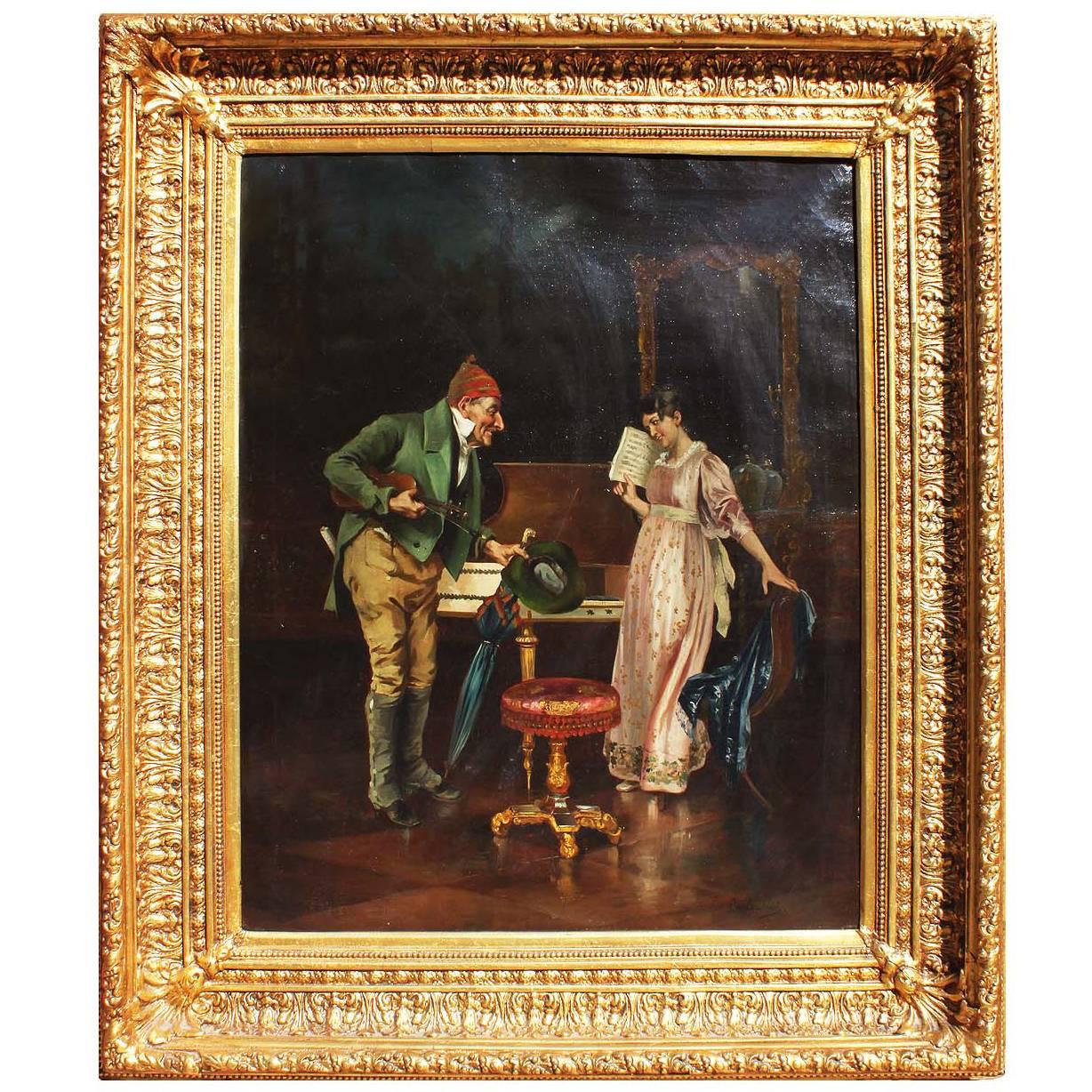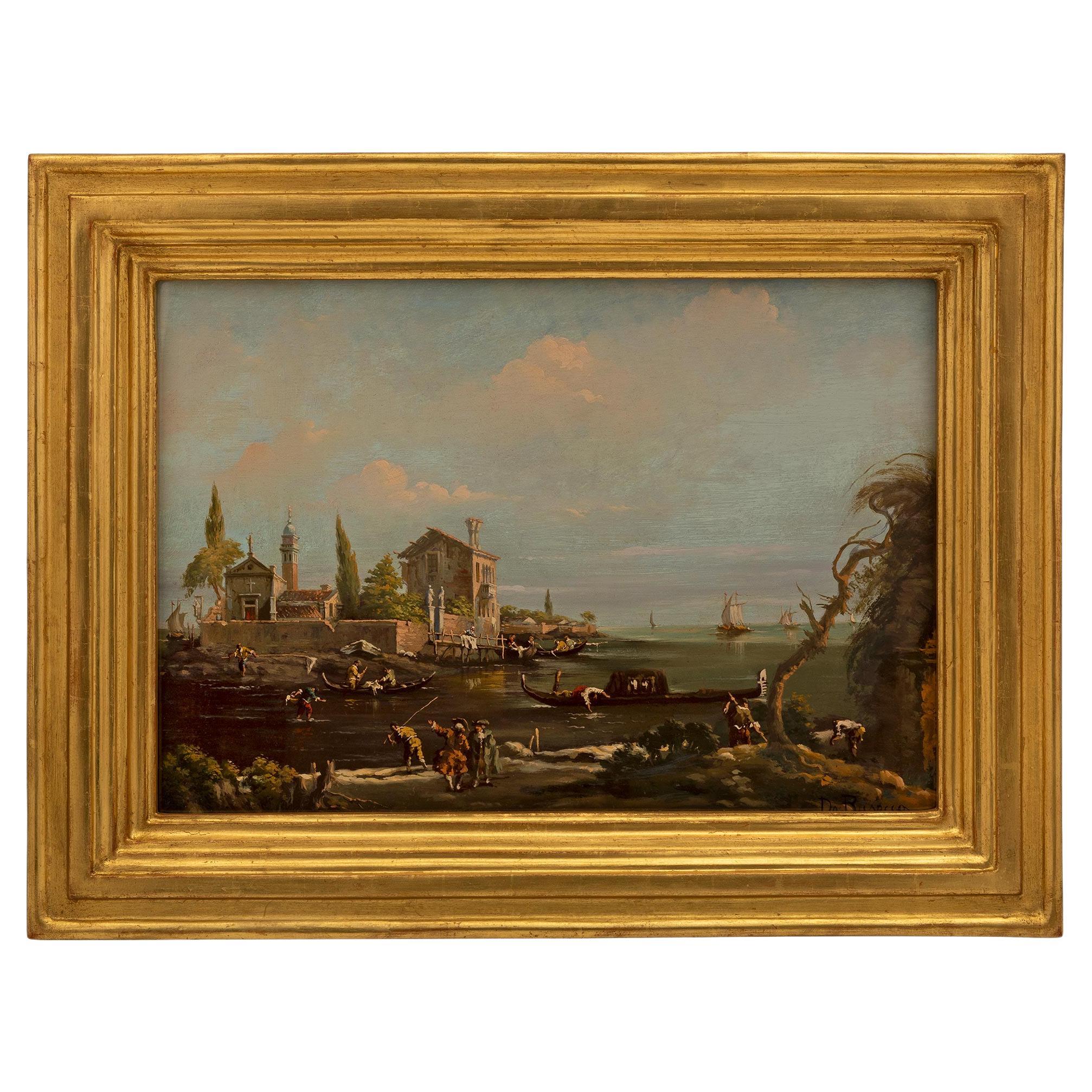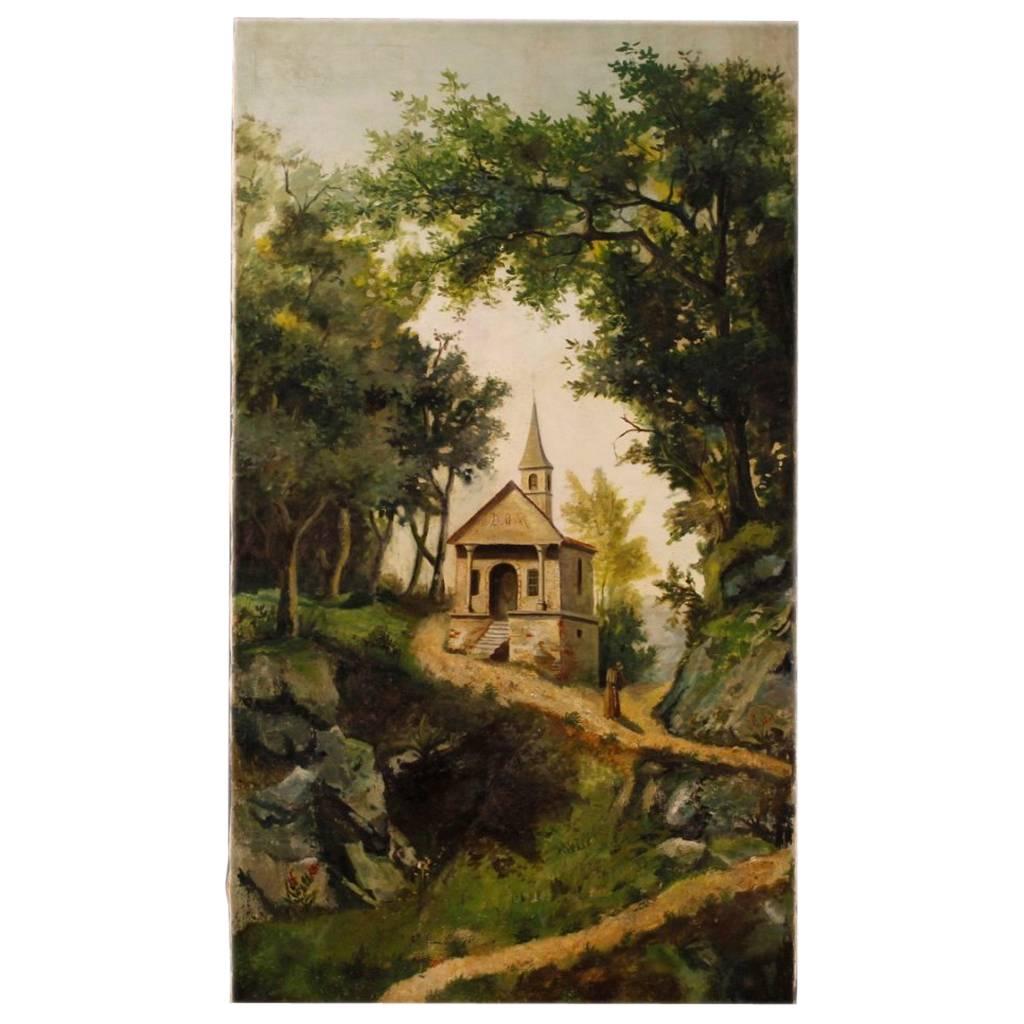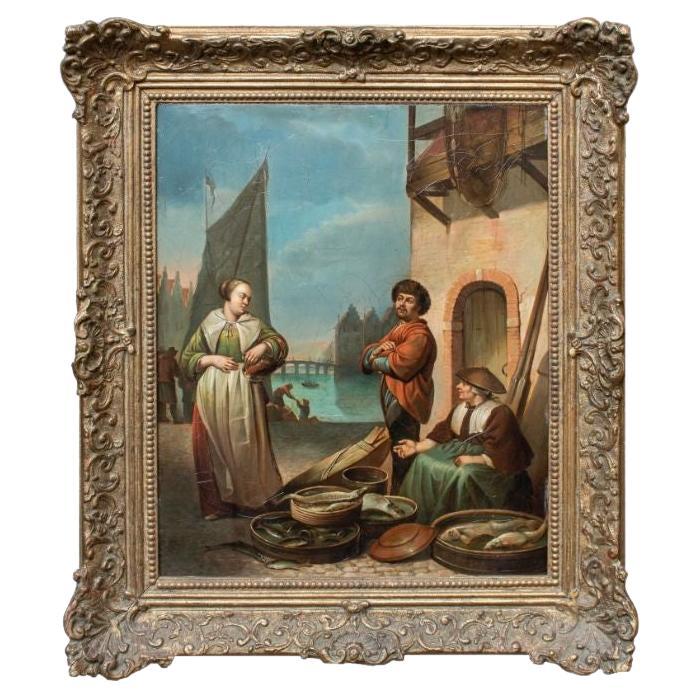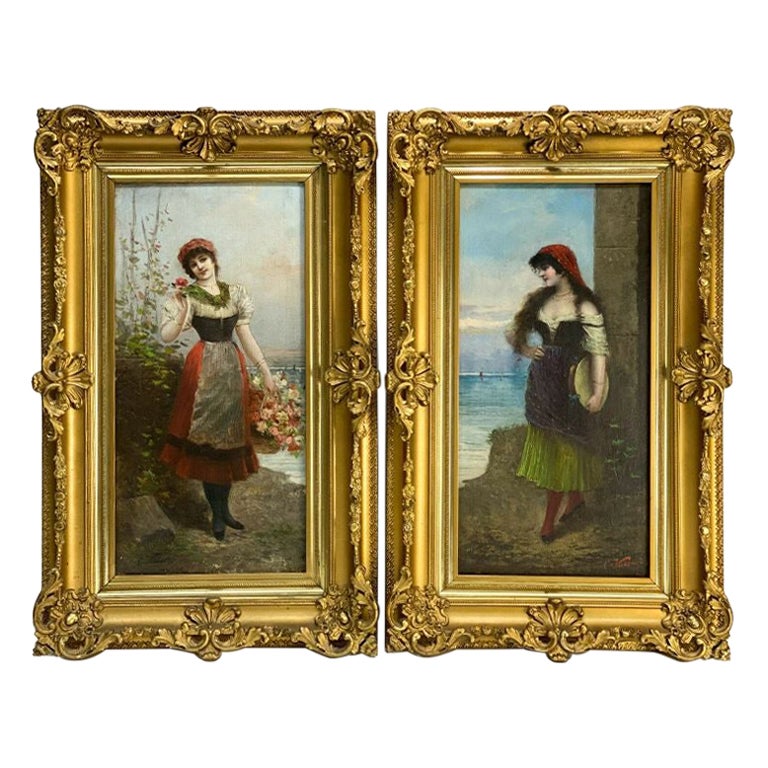Items Similar to 19th Century, Italian Oil on Canvas, Market at Giaveno Tower by Carlo Piacenza
Want more images or videos?
Request additional images or videos from the seller
1 of 8
19th Century, Italian Oil on Canvas, Market at Giaveno Tower by Carlo Piacenza
About the Item
Carlo Piacenza (Italy -Turin, December 3, 1814 - Castiglione Torinese, 1887)
Market at the Giaveno Tower
Italy, Piedmont, 1850-1860
Oil on canvas
The oil on canvas painting represents a market scene in a town in which stands in a dominant position a circular tower of medieval age. The work can be attributed to the Italian Piedmontese painter Carlo Piacenza (Turin, 3 December 1814 - Castiglione Torinese, 1887). Another comparable work, made with oil on a panel, signed and dated in the lower left, is known from Piacenza and portraying a Market at the Tower. The architectural context represented in the latter is the same as the canvas, although there are some small variations. The same goes for the daily life scene described. The painting on panel, now in private collection, is published by Piergiorgio Dragone in « 19th century painters in Piedmont. Art and figurative culture. 1830-1865 », published by the CRT Bank of Turin. As can be seen from the comparison between the two works, the tower is the same, as the adjacent house on the left.
Some differences can be found by observing the access steps to the environment housed in the tower, perhaps a workshop, as well as the description of the wooden fences to protect the balconies of the house next door. In the version on canvas Piacenza inserts, in the masonry of the tower, a clock surrounded by terracotta tiles and describes in a better state of conservation the buildings that follow each other on the right. The horizontal cut of the canvas also allows the painter an accurate description of the surrounding environment. On the right a street of the town disappears on the horizon, while in the foreground, on the widening where the market is located, there is a wall surrounding a lush private garden. In both works the cloths spread out, some pots in terracotta with ornamental plants, the branch of a green plant that climbs the tower, as well as the inhabitants intent in their mercantile activities, give back the experience of the country and liven up the composition.
Through the comparison with some documents found, it is possible to identify the exact place represented in the paintings: it is one of the medieval towers of the town of Giaveno, near Turin in the north of Italy.
There is an etching signed by Francesco Mennyey (Turin 1889 - 1950), an internationally known painter and engraver in the first half of the 20th century, which represents the same view described by Piacenza. Mennyey signs and titles engraving “Giaveno”.
The comparison with the engraver, made around 1920, allows not only to ascertain the place of the painting in question, but also to show that the clock that Piacenza describes in the canvas is an addition of invention that the artist thought perhaps necessary to enrich the simple medieval architecture, balancing the whole with a chromatic appeal in the tones of red. The tower represented is still present today. Giaveno, a municipality not far from Turin and located at the mouth of the Val Sangone, has very ancient origins. The first settlement dates back to Roman times, but it gained importance in the central centuries of the Middle Ages, when it was subjected to the lordship of the powerful abbots of the Sacra di San Michele. In 1209, thanks to a donation by the Count of Savoy Thomas I, the abbots of San Michele fortified the square with a city wall and built a castle. In 1347, the abbot Rodolfo of Mombello raised the walls, interspersed with five circular towers. The perimeter of the Abbey Citadel is still quite readable in the current Via Roma. Three towers, although modified over the centuries, have survived the walls. A circular plan, made of mortar and river stones, they have at the top a decorative band in brick that forms a geometric design with small arches. Some historical photographs indicate the opening and closing of some windows and the evolution of the site.
Carlo Piacenza was born in Turin in 1814 and trained at the Accademia Albertina, a pupil of Cesare Biscarra and Pietro Fea. After a period of apprenticeship at the Bernese watercolourist Juillerat, he began to paint subjects inspired by the Piedmontese and Aosta countryside, with the intention of portraying the "true" of nature. Debuts to the Promotrice of Turin in 1843 presenting some views characterized by a calm naturalism and a romantic and idyllic intonation, sometimes melancholy. The gifts of a naturalist painter are intensified with the luministic research that the setting can offer. Piacenza thus achieves high results through its own and personal modulation of light, obtaining critical consents to the Turin exhibitions in which it regularly participates, in particular those held at the Promotrice and at the Circle of Artists. He dedicated himself to private teaching and had as students the children of Duke Ferdinand of Genoa, Thomas and Margaret of Savoy. Since 1856 he has also held the Chair of Drawing at the Turin Military Academy, which held until his death in 1887. The painting of Carlo Piacenza continues, alongside that of his friend and colleague Angelo Beccaria, a vein of serene landscape that had distinguished the first half of the 19th century. Piacenza, however, is innovative in the artistic landscape of Piedmont for a marked attention to concrete moments of daily news, thus giving connotations of verism to his works.
The canvas that is the subject of this study appears to be significant within the artistic path of Piacenza. The true description of the landscape is enlivened by the market scene and in which the chromatic research finds ample development in the rendering of the zones of shadow and the warm summer light. The work is also a document of historical interest for the architectural events that have affected the town of Giaveno, testimony of a place today strongly transformed by urban adaptations.
We apologize for any translation errors from Italian.
- Attributed to:Carlo Piacenza (Author)
- Dimensions:Height: 48.43 in (123 cm)Width: 34.26 in (87 cm)Depth: 1.19 in (3 cm)
- Style:Romantic (Of the Period)
- Materials and Techniques:
- Place of Origin:
- Period:
- Date of Manufacture:1850-1860
- Condition:
- Seller Location:IT
- Reference Number:1stDibs: LU4405218450502
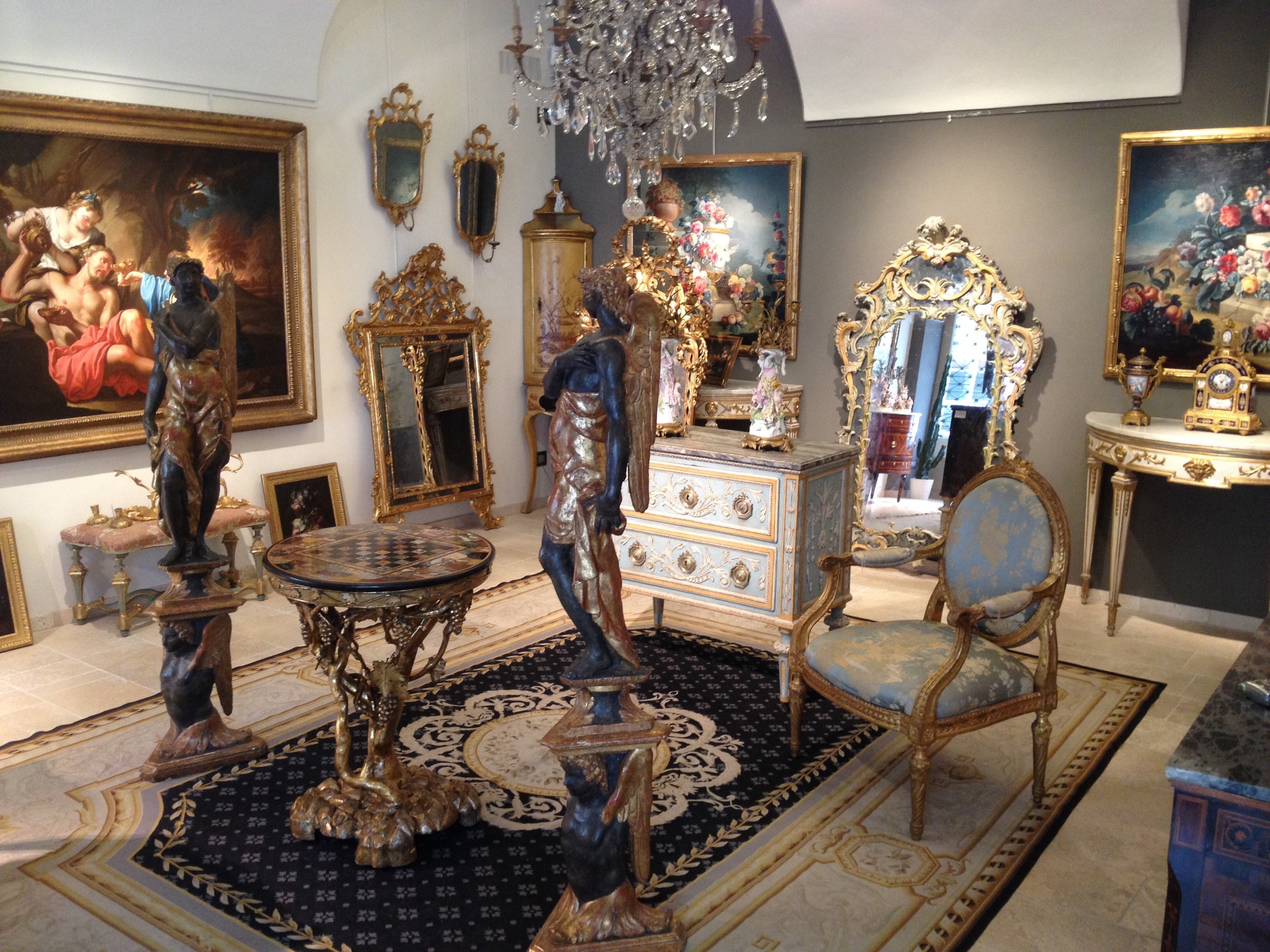
About the Seller
5.0
Platinum Seller
These expertly vetted sellers are 1stDibs' most experienced sellers and are rated highest by our customers.
Established in 1980
1stDibs seller since 2019
42 sales on 1stDibs
Typical response time: 2 hours
- ShippingRetrieving quote...Ships From: Italy
- Return PolicyA return for this item may be initiated within 7 days of delivery.
More From This SellerView All
- 19th Century, Oil on Canvas, Italian View of the Forum Boario of RomeLocated in IT19th century, oil on canvas, Italian View of the forum Boario of Rome The fine painting represents the Piazza della Bocca della Verità, located in the Ripa district, in the area of the Foro Boario, the oldest market in Rome (Italy). On the right is described the Roman Temple of about 100 B.C. wrongly called of Vesta, circular Corinthian monopter with cell of white marble ashlar and twenty fluted columns. From the 12th century it was reused as a church dedicated to Santo Stefano delle carrozze, then, in the 18th century, in Santa Maria del Sole. On the right you can see the fountain called "dei tritoni" which was built in 1717 on a design by architect Carlo Bizzaccheri. The fountain has a star-shaped bathtub, in honour of the commissioner, the Pope Clement XI...Category
Antique Early 19th Century Italian Neoclassical Paintings
MaterialsCanvas
- 18th Century, Italian Oil on Canvas Still Life by Pietro NavarraLocated in IT18th century, Italian oil on canvas still life by Pietro Navarra Oil on canvas, canvas measures: cm H 103 x W 164, framed measures...Category
Antique 18th Century Italian Baroque Paintings
MaterialsCanvas
- 18th Century, Italian Pair of Oil on Canvas Paintings by Francesco SimoniniBy SIMONINILocated in ITFrancesco Simonini (Parma, 16 June 1686 - Parma, 1766) “The rest of the soldiers” and “The march of soldiers” oil on canvas The very fine paintings, attributable to the painte...Category
Antique Early 18th Century Italian Baroque Paintings
MaterialsCanvas
- 18th Century Italian Oil on Canvas Painting with Battle by Antonio CalzaBy Antonio CalzaLocated in ITAntonio Calza (Italy, Verona, 1653-18th April 1725) "Battle between Christian and Turkish cavalry with castle" The painting depicts a bloody battle between Christian and Turkish cavalry. Characterized by dynamism, intensity of color and light, the main scene occupies the lower horizontal section of the canvas, optically interrupted by the black fumes of the shots from which emerge, on the left, the towers of a fortress. On the right, in the distance you can see the combat in progress in the countryside, beyond which you can see the pale presence of hills that create a fifth, marking the horizon. To frame the scene contributes to the left, against light and in the foreground, a portion of the wall. The painter, however, introduces a horse on the ground, of which we see only the back, a ruse to involve the observer making him become active and participate in the scene. In the foreground, lifeless bodies, wounded horses and, scattered on the ground, weapons and a drum enhance the drama of the clash. The excitement and expressive force, the intense chromatic range attentive to the conditions of light and the fine brushstrokes, decisive and dramatic, suggests the attribution to Antonio Calza, one of the most important painters of battles of the seventeenth century, excellent student and continuator of the greatest interpreter of the genre, Jacques Courtois called il Borgognone (Saint-Hyppolite 1621 - Rome 1676). Il Borgognone, although not having had a real school or direct students, places itself as a primary reference point by the Italian and foreign "battaglisti". The genre of battle painting found great success in the collections of the Italian and European nobility of the seventeenth and eighteenth centuries. The battles of the Italian Renaissance, in which the scene converged towards a precise protagonist, evolve towards a type of combat "without hero". The bloody realism of the details and the dynamic development of the narrative confuse the figure of the protagonist, when present, to give importance to the swirl of horses and armed fighters, among which, moreover, does not emerge a winner. The certain documents relating to the life and movements of Antonio Calza are scarce; it was equally difficult to reconstruct, from the critics, a catalogue of autograph works. Through paintings in private collections, in museums and paintings passed on the antiques market it has been possible to identify a copious corpus of works that can be traced back to his hand. The work of art historians, together with that of antique dealers, in conferring proper attributions in order to best outline the figure of Calza, continues but studies are still in progress. In this sense, the work of Giancarlo Sestieri should certainly be noted, who investigated the artistic production of the battaglisti and Calza, thus allowing the comparison of the numerous photographic works reported, to identify and recognize the stylistic qualities that distinguish the corpus of paintings assigned to him today. Antonio Calza was born in 1653 in Italy, in Verona and in 1664 he entered the school of Carlo Cignani in Bologna, dedicating himself to painting battles and landscapes. He then perfected in Rome, where he knew the works of the then undisputed head of the sector, Jacques Courtois called the Burgundian. In 1675 he returned to Verona and married an 88-year-old widow who, dying, left him a rich inheritance. Much appreciated by the nobility and the bourgeoisie, he received numerous commissions. Bartolomeo Dal Pozzo (Le Vite de' pittori, de gli scultori et architetti veronesi, 1718) praises "three great paintings of battles...Category
Antique Late 17th Century Italian Baroque Paintings
MaterialsCanvas
- 19th Century Four Italian Oil on Panel with Allegory of the Four ElementsLocated in IT19th century four Italian oil on panel with allegory of the four elements Dimensions with frame: cm H 34.5 x L 25; only the table: cm H 29 x L 20.5 The funny oil on panel, by an artist active in Piedmont, in the north of Ital, in the first half of the 19th century, represent the allegory of the four elements of the Earth. They are inspired by the group of four etching prints of circa 1730, made to a design by Rococo painter Jacopo Amigoni (Naples 1682- Paris 1752) and engraved in Venice by Joseph Wagner...Category
Antique 19th Century Italian Rococo Paintings
MaterialsWood
- 18th Century, Italian Oil on Canvas Painting with Landscape with RuinsLocated in IT18th century, Italian oil on canvas painting with landscape with ruins Measures: only the canvas cm W 97.5 x H 108; with the frame cm W 103.5 x H 114 x D 5 The fine oil on canv...Category
Antique 18th Century Italian Baroque Paintings
MaterialsCanvas
You May Also Like
- Italian 19th Century Oil on Canvas "The Music Professor" Carlo SassiBy Carlo SassiLocated in Los Angeles, CAItalian 19th century oil on canvas titled "The Music Professor" depicting a mid-19th century music-room scene of an elder man, the music professor, holding his violin, hat and umbrel...Category
Antique 19th Century Italian Other Paintings
MaterialsGesso, Canvas, Wood
- Italian 19th Century Oil on Canvas PaintingLocated in West Palm Beach, FLA beautiful Italian 19th century oil on canvas painting. The painting depicts a beautiful Italian scene of personages going about their day with charming boats and a house on the wat...Category
Antique 19th Century Italian Paintings
MaterialsCanvas, Giltwood
- 19th Century French Oil on Canvas “at the Fountain”Located in LA CIOTAT, FRA delightful oil on canvas, “At the Fountain”, by the Provençal artist Bernard Langrune (1889 – 1961). Known for his paintings of regional scenes, from pastoral views to city snapshots, Langrune has beautifully captured this atmospheric moment in a quiet and shadowy corner of a French town. You can almost hear the splashing...Category
Antique 19th Century French Paintings
MaterialsCanvas
- Antique Italian Landscape Painting Oil on Canvas from 19th CenturyLocated in Vicoforte, PiedmontGreat antique Italian painting from the second half of the 19th century. Oil painting on canvas depicting countryside landscape of romantic style. Framework that has undergone a cons...Category
Antique 1880s Italian Romantic Paintings
MaterialsCanvas
- 19th Century Market Scene Painting Oil on CopperLocated in Milan, ITCircle of Abraham van Strij (Holland, 1753 - 1826) Market scene Oil on copper, 45 x 36 With frame 60 x 50 cm The lively port everyday life that transpires from this pain...Category
Antique 19th Century Dutch Paintings
MaterialsCopper
- Pair of Carlo Valensi Oil on Canvas Paintings of Beauties Italian, 19th CenturyLocated in Gardena, CAPair of carlo valensi oil on canvas paintings of Beauties Italian, 19th century. A pair of carlo valensi (Italian 19th Century) oil on canvas portrait paintings, circa 1900. The p...Category
Antique 19th Century Paintings
MaterialsPaint
Recently Viewed
View AllMore Ways To Browse
Painted Canvas Wall Panel
Antique Market Place
Over Door Decorations
Italian 19th Century Engravings
Painted Antique High Chair
Italian Military
Mid Century Arched Door
Garden Tower
Used Tower Garden
Piedmont Furniture
Italian Architectural Arches
Mid Century Wooden Wall Light
Arch Wall Light
Midcentury Wooden Wall Light
Mid Century Italian Tile
Mid Century Chair Other Antique Furniture
Mid Century Chairs Other Antique Furniture
19th Military Painting
